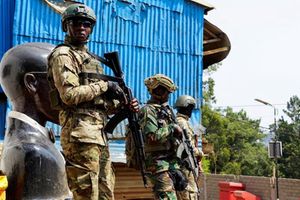In the race to eradicate polio

2024-25 RI President Stephanie Urchick at Rotary International Headquarters in Evanston, Illinois, USA in this photo taken on December 7, 2023.
What you need to know:
- According to the World Health Organization, polio is a contagious disease caused by the poliovirus, which attacks the nervous system and can lead to complete paralysis in a matter of hours.
In 1988, more than 300,000 cases of wild polio were reported across 125 countries. By 2023, the numbers had dropped to 12 cases in just two countries: Afghanistan and Pakistan.
Yet, in recent months, polio has been detected in countries that had been declared polio-free.
For instance, in December last year, poliovirus was detected in many wastewater treatment plants in European cities. Notably, no human case was reported.
According to the World Health Organization, polio is a contagious disease caused by the poliovirus, which attacks the nervous system and can lead to complete paralysis in a matter of hours. The virus spreads primarily through direct contact with infected faeces or, less commonly, through contaminated food or water.
Wild poliovirus (WPV) is a naturally occurring type of poliovirus. WHO notes that outbreaks of variant poliovirus can occur when vaccination coverage is insufficient. In these cases, the weakened version of the virus found in the oral polio vaccine can circulate within under-vaccinated communities for extended periods, leading to new infections.
Vaccinated children shed the weakened poliovirus strains into the environment through their digestive systems. These strains can then spread to unvaccinated individuals, particularly in areas with inadequate sanitation and a lack of access to clean drinking water, which further facilitates the transmission. Polio, WHO notes, mainly affects children under five years of age.
Healthy Nation had a sit down with Stephanie Urchick, Rotary International president on the organisation’s role as part of the Global Polio Eradication Initiative.
Rotary has focused on polio since 1988. Why?
It's important because it's a promise that we made to the children of the world. When we made that promise, polio was running around more than 125 countries. Now, polio is only in two countries, and it's not even the whole country.
There's a border between Afghanistan and Pakistan. It's kind of a mountainous region. That's the last place that we have to work very hard to get rid of the wild poliovirus.
What moments stick to you when you reflect on the journey to eradicating polio?
My very first trip to India, when, as a fairly new Rotarian, I went to help immunise babies against polio. At the beginning of the day, one of the Rotarians said that we were going to immunise 125 million children on that specific day. I said, What? 125 million children? I thought, how is that possible? Well, at the end of the day, I knew. Because there was not a single Rotarian who stayed home. So, it's no wonder that they could do so many immunisations in one day, because everybody was behind it.
And indeed, 125 million children were immunised in that one day. It was amazing.
There have been cases of vaccine empathy in recent years. How do you contend with vaccine-hesitant groups?
We have a number of strong partners, and a strong committee called the International PolioPlus Committee (IPCC). And they strategise on ways to go and deal with those kinds of obstacles. And so we figure out ways to go around or make it work.
So, in the case of misinformation, it means that we need a group of people to sensitise communities. We need to educate people about the power of vaccines and how they can actually help children. So, depending on what we encounter, we have strategies that help us figure out how to move in a new direction.
What does the future look like in the fight against polio?
Rotary will continue its efforts to eradicate polio and what we are seeing is that many of the countries that report cases are reporting cases of polio variant, derived from the vaccine itself. The good news is that this is where we have made progress in the last several years. There were literally hundreds of cases each year of children who would get polio from the vaccine and that has come down dramatically. We are making tremendous progress there. So ultimately, we will get to the point of no more of those cases will happen. It is a matter of when polio will be eradicated, not if.
Rotary recently added environmental sustainability as a core pillar. How is this bein implemented in Kenya and Africa?
Well, I don't think anybody can deny that the planet is giving us signs. It's telling us— take care of me, take care of me. We have fires, we have floods, we have hurricanes, cyclones; all kinds of things happening all over the world.
It's a call to action for us to preserve what we have and to leave a planet in good shape for those who are coming behind us. So, I'm delighted that this is the newest area of focus, because it really can have an impact in so many different ways.
lnjeru@ke.nationmedia.com


